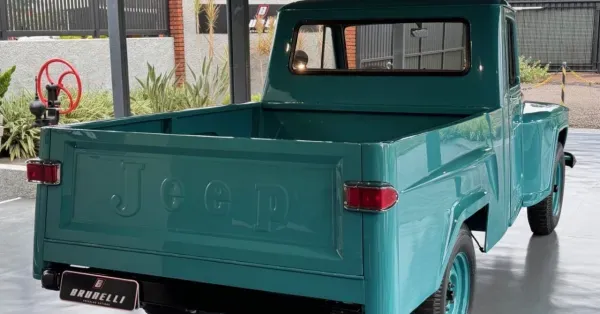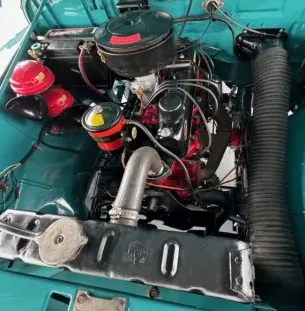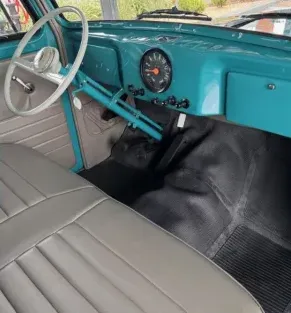In 1965, a true icon of the automobile industry was launched in the United States, destined to become a symbol of resistance It is durability: the Willys Pick-Up Jeep. This vehicle, designed to face the toughest challenges, has conquered not only North American roads, but also the hearts of Brazilians. Its robust design and your unique capacity handling inhospitable terrain have made it a preferred choice for both farm workers and urban adventurers.
American and Brazilian Conquest

The history of Willys Pick-Up Jeep 1965 began in the United States, but quickly crossed borders, finding fertile ground in Brazil to demonstrate its qualities. With a sturdy chassis is reliable mechanics, the Willys Jeep has become an essential part of the country's rural and urban daily life. In Brazil, it stood out as a practical and robust vehicle, ideal for those who needed a work companion or for adventures far from the asphalt.
Design and Versatility
The success of Willys Jeep can also be attributed to your multifunctional design. Its body allowed for several configurations, making it adaptable to the cargo transportation or passengers. This has made it an indispensable tool for workers in different sectors. In addition, its robust aesthetics and confidently won over both functionality and appearance.
Performance on Difficult Terrain
One of the most celebrated features of Willys Pick-Up Jeep 1965 is your ability to face challenging paths. Equipped with four-wheel drive and a reliable engine, it was capable of overcoming obstacles that would leave other vehicles behind. This performance made it the preferred choice for those who needed to go beyond the asphalt, whether on dirt roads in the countryside or on the most rugged trails.
A Symbol of Durability

Durability is a hallmark of Willys Jeep. Many 1965 models still circulate on Brazilian roads, proof that they were built to last. Its longevity is the result of solid construction and the use of high quality materials, which guaranteed the vehicle a exceptionally long service life, even under heavy use.
Cultural Impact in Brazil
A Willys Pick-Up Jeep 1965 was not just a means of transportation; it became a cultural symbol in Brazil. Representing independence It is ability to overcome, it reflected the values of an era marked by optimism and economic growth. In rural and urban areas, it was common to see the Jeep as an essential part of everyday life, whether for hard work or leisure time.
Adaptation to Local Needs
Understanding the specific demands of the Brazilian market, Willys Jeep underwent adaptations that maximized its efficiency. Adjustments in engine and in suspension ensured that the vehicle could tackle the variety of terrains found in Brazil, from sandy beaches to dirt roads.
Willys Jeep Legacy
The legacy of Willys Pick-Up Jeep 1965 is unquestionable. She established new standards durability and versatility, inspiring a generation of vehicles that sought to replicate its exceptional qualities. Today, it is seen as a icon of the engineering and design of the time, admired by both collectors and enthusiasts.
Preservation and Restoration

Nowadays, there is growing interest in preserve and restore old Willys Jeep models. These projects not only keep the vehicle's history alive, but also enhance its value. historical importance. Restorers dedicate time and resources to ensure that future generations can admire this landmark of the automotive industry.
Innovations and Sales Success
In 1966, the Willys Pick-Up Jeep led the utility segment, reaching more than 50% of sales. During this period, measures were taken to reduce consumption, such as the review of the carburetor calibration. In 1968, the engine was launched Willys 3000, with 3 liters of displacement It is 132 horsepower, increasing the pickup’s performance.
With the acquisition of Willys by Ford, new advances were introduced. The plant of Taubate, in São Paulo, began producing engines for both the local market and for export. In 1975, the old six-cylinder engine was replaced by a more modern and efficient model, ensuring even greater performance and economy.
The End of an Era
Despite its success and numerous innovations, the production of the valiant Willys Pick-Up Jeep was closed in 1983. The decision left many enthusiasts disappointed, marking the end of a cycle for a vehicle that had become a symbol of resistance It is innovation.
Conclusion

A Willys Pick-Up Jeep 1965 was more than a vehicle; it was a revolution. From its introduction in the United States to its consecration in Brazil, it represented the best of automotive engineering of its time. Today, it is a true relic, admired for her quality It is functionality, and preserved by those who recognize its historical value.
If you are lucky enough to find one Willys Jeep 1965 still running, know that you are in front of a living piece of automotive history. Its legacy continues to inspire, showing that resistance It is innovation never go out of style. And so, even in 2024, The Willys Jeep remains an example of how a passion for engineering can span generations.









